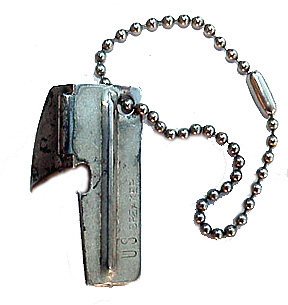The Army’s Best Invention – The P-38
Story by Maj. Renita Foster
It was developed in just 30 days in the summer of 1942 by the Subsistence Research Laboratory in Chicago. And never in its 52-year history has it been known to break, rust, need sharpening or polishing. Perhaps that is why many soldiers, past and present, regard the P-38 C-ration can opener as the Army’s best invention.
C-rations have long since been replaced with the more convenient Meals, Ready to Eat, but the fame of the P-38 persists, thanks to the many uses stemming from the unique blend of ingenuity and creativity all soldiers seem to have.
“The P-38 is one of those tools you keep and never want to get rid of,” said Sgt. Scott Kiraly, a military policeman. “I’ve had my P-38 since joining the Army 11 years ago and kept it because I can use it as a screwdriver, knife, anything.”
The most vital use of the P-38, however, is the very mission it was designed for, said Fort Monmouth, N.J., garrison commander Col. Paul Baerman.
“When we had C-rations, the P-38 was your access to food; that made it the hierarchy of needs,” Baerman said. “Then soldiers discovered it was an extremely simple, lightweight, multipurpose tool. I think in warfare, the simpler something is and the easier access it has, the more you’re going to use it. The P-38 had all of those things going for it.”
The tool acquired its name from the 38 punctures required to open a C-ration can, and from the boast that it performed with the speed of the World War II P-38 fighter plane.
“Soldiers just took to the P-38 naturally,” said World War II veteran John Bandola. “It was our means for eating 90 percent of the time, but we also used it for cleaning boots and fingernails, as a screwdriver, you name it. We all carried it on our dog tags or key rings.”
When Bandola attached his first and only P-38 to his key ring a half century ago, it accompanied him to Anzio, Salerno and through northern Italy. It was with him when World War II ended, and it’s with him now.
“This P-38 is a symbol of my life then,” said Bandola. “The Army, the training, my fellow soldiers, all the times we shared during a world war.”
Sgt. Ted Paquet, swing shift supervisor in the Fort Monmouth Provost Marshal’s Office, was a 17-year-old seaman serving aboard the amphibious assault ship USS New Orleans during the Vietnam war when he got his first P-38. The ship’s mission was to transport Marines off the coast of Da Nang.
On occasional evenings, Marines gathered near Paquet’s duty position on the fantail for simple pleasures like “Cokes, cigarettes, conversation and C-rations.” It was during one of these nightly sessions that Paquet came in contact with the P-38, or “John Wayne” as it’s referred to in the Navy.
Paquet still carries his P-38, and he still finds it useful. While driving with his older brother, Paul, their car’s carburetor began to have problems.
“There were no tools in the car and, almost simultaneously, both of us reached for P-38s attached to our key rings,” Paquet said with a grin. “We used my P-38 to adjust the flow valve, the car worked perfectly, and we went on our merry way.”
Paquet”s P-38 is in a special box with his dog tags, a .50-caliber round from the ship he served on, his Vietnam Service Medal, South Vietnamese money and a surrender leaflet from Operation Desert Storm provided by a nephew.
“It will probably be on my dresser until the day I die,” Paquet said.
The feelings veterans have for the P-38 aren’t hard to understand, according to 1st Sgt. Steve Wilson of the Chaplain Center and School at Fort Monmouth.
“When you hang on to something for 26 years,” he said, “it’s very hard to give it up. That’s why people keep their P-38 just like they do their dog tags. … It means a lot. It’s become part of you. You remember field problems, jumping at 3 a.m. and moving out. A P-38 has you reliving all the adventures that came with soldiering in the armed forces. Yes, the P-38 opened cans, but it did much more. Any soldier will tell you that.”
Courtesy of “Soldier’s Online”

